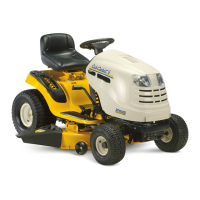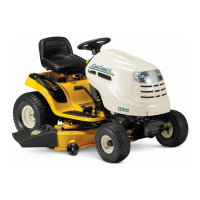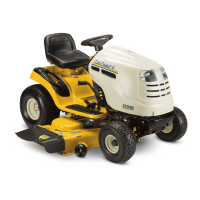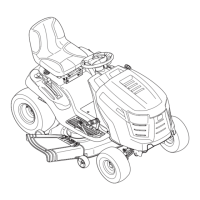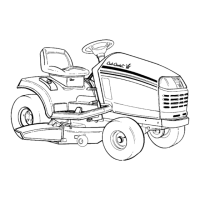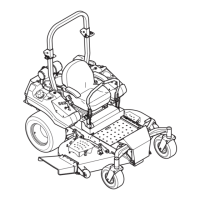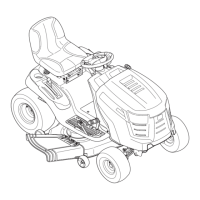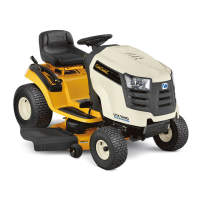Figure 7-6
5. Test the blade’s balance using a blade balancer. Grind
metal from the heavy side until it balances evenly.
NOTE: When replacing the blade, be sure to install the blade with
the side of the blade marked ‘‘Bottom’’ (or with a part number
stamped in it) facing the ground when the mower is in the
operating position.
CAUTION: Use a torque wrench to tighten the
blade spindle hex flange nut to between 70 ft-lbs
and 90 ft-lbs.
Battery
CALIFORNIA PROPOSITION 65 WARNING:
Battery posts, terminals, and related accessories
contain lead and lead compounds, chemicals known
to the State of California to cause cancer and
reproductive harm. Wash hands after handling.
CAUTION: If removing the battery, disconnect the
NEGATIVE (Black) wire from it’s terminal first,
followed by the POSITIVE (Red) wire. When
reinstalling the battery, always connect the POSITIVE
(Red) wire its terminal first, followed by the
NEGATIVE (Black) wire.
Jump Starting
WARNING! Never jump start a damaged or frozen
battery. Be certain the vehicles do not touch, and
ignitions are off. Do not allow cable clamps to touch.
Connect positive (+) cable to positive (+)post of your
tractor’s discharged battery.
2. Connect the other end of the cable to the positive (+) post
of the jumper battery.
Connect the second cable negative (–) to the other post of
the jumper battery.
4. Make the final connection on the engine block of the
tractor, away from the battery. Attach to an unpainted part
to assure a good connection.
CAUTION: If the jumper battery is installed on a
vehicle (i.e. car, truck), do NOT start the vehicle’s
engine when jump starting your tractor.
5. Start the tractor (as instructed in the Operation section of
this manual).
6. Set the tractor’s parking brake before removing the jumper
cables, in reverse order of connection.
Charging
WARNING! Batteries give off an explosive gas
while charging. Charge the battery in a well
ventilated area and keep away from an open flame
or pilot light as on a water heater, space heater,
furnace, clothes dryer or other gas appliances.
CAUTION: When charging your tractor’s battery,
batteries. Read your battery charger’s Owner’s
Manual prior to charging your tractor’s battery.
Always follow its instructions and heed its warnings.
If your tractor has not been put into use for an extended period
of time, charge the battery as follows:
2. If your battery charger is automatic, charge the battery
until the charger indicates that charging is complete. If the
charger is not automatic, charge for no fewer than eight
hours.
Fuse
WARNING! Before servicing, repairing, or
inspecting, always disengage PTO, set parking
brake, stop engine and remove key to prevent
unintended starting.
A fuse is installed in your tractor’s wiring harness to protect the
tractor’s electrical system from damage caused by excessive
amperage.
If the electrical system does not function, or your tractor’s engine
will not crank, check to be certain that the fuse has not blown. It
is located under the hood, mounted behind the top of the dash
panel on the support bar.
CAUTION: Always use a replacement fuse with the
same amperage capacity as the blown fuse.
26 Section 7— Service
